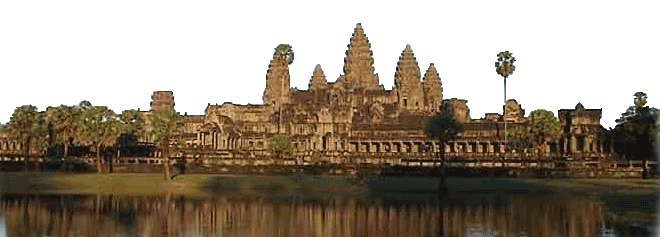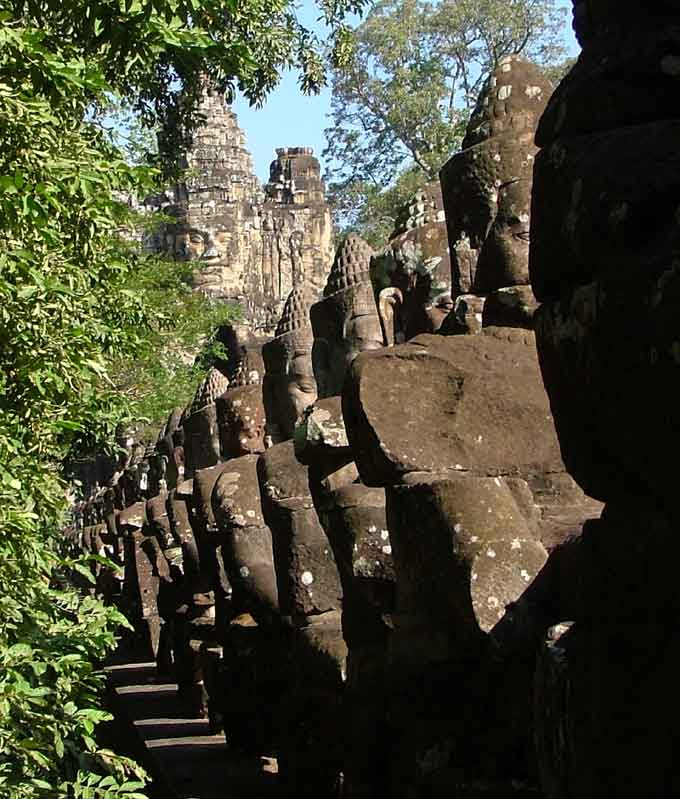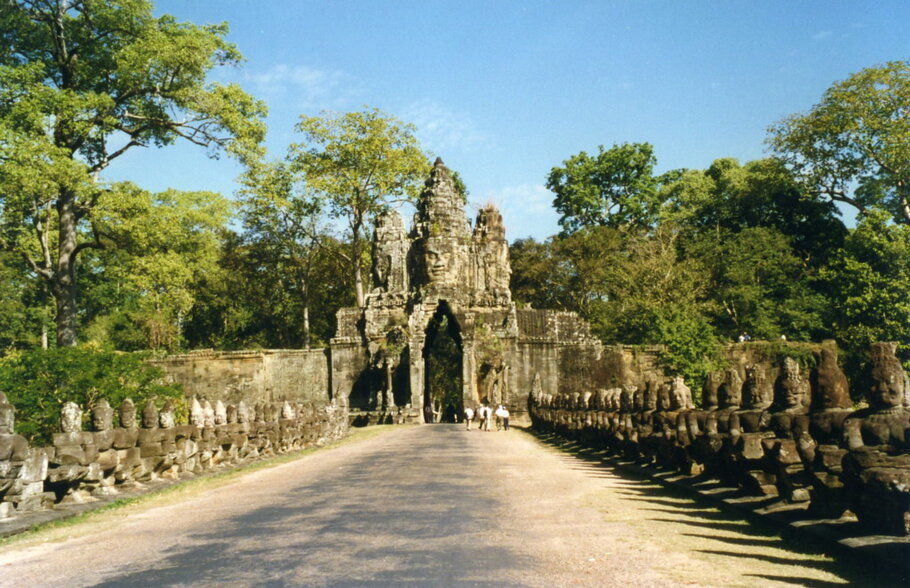Cambodge temple d'Angkor - South Gate

Cambodge temple d'Angkor
SOUTH GATE**
The South Gate is one of the main entrances to the ancient Khmer capital of Angkor Thom, built during the reign of King Jayavarman VII in the late 12th century. Located to the south of the city, this monumental gate is not only an essential step for accessing the city, but also a remarkable work of art and architecture.
The South Gate is a massive stone structure, measuring approximately 23 meters high, 80 meters wide, and 25 meters deep. It is flanked by two gigantic figures of deities and demons, illustrating the mythological scene of the "Churning of the Ocean of Milk," an iconic motif in Khmer art.
Atop the gate are four giant facial figures, often considered to represent King Jayavarman VII or protective deities, symbolizing the vigilance and power of the city. The façade is adorned with detailed bas-reliefs depicting deities, warriors, and mythological scenes, testifying to the artistic and religious richness of the period.
The gate is accessible via a bridge spanning a wide pool, reinforcing the monumental and ceremonial effect of the entrance.
The south gate, like the other gates of Angkor Thom, is designed to impress and reassure, affirming the king's power and his connection with the divine. The scene of the "Churning of the Ocean of Milk" evokes the idea of the cosmic struggle between good and evil, symbolizing the stability and cosmic order that the king claimed to embody.
The grandeur and finesse of the sculptures attest to the remarkable skill of Khmer artisans. The symmetrical arrangement and complexity of the bas-reliefs reflect an advanced mastery of the art of stone carving.
In addition to its symbolic role, the south gate also served as a strategic point to control access to the city and for defense.
The South Gate of Angkor Thom is an iconic gateway that combines function, religious symbolism, and artistic expression. It represents the power of the Khmer Empire in the 12th century, while also being a masterpiece of architecture and sculpture. During your visit, this gate offers an immersion in the grandeur of ancient Khmer art and the spirituality that animated the city of Angkor.
Localisation :
Au Sud d'Angkor Thom
Commentaire :
« South Gate », aussi appelé la porte sud, est l'une des principales entrées de l'enceinte de l'ancienne capitale khmère d'Angkor Thom, construite sous le règne du roi Jayavarman VII à la fin du XIIe siècle. Située au sud de la cité, cette porte monumentale est non seulement une étape essentielle pour accéder à la ville, mais aussi une œuvre d'art et d'architecture remarquable.
La porte sud est une structure en pierre massive, mesurant environ 23 mètres de haut, 80 mètres de large et 25 mètres de profondeur. Elle est encadrée par deux gigantesques figures de déités et de démons, illustrant la mythologique scène du « Churning of the Ocean of Milk » (le barattage de la mer de lait), un motif emblématique de l’art khmer.
Au sommet de la porte, on trouve quatre figures de visage géantes, souvent considérées comme représentant le roi Jayavarman VII ou des divinités protectrices, symbolisant la vigilance et la puissance de la cité.
La façade est ornée de bas-reliefs détaillés, représentant des déités, des guerriers, et des scènes mythologiques, témoins de la richesse artistique et religieuse de l’époque.
La porte est accessible via un pont enjambant un large bassin, renforçant l’effet monumental et cérémoniel de l’entrée.
La porte sud, comme les autres portes d’Angkor Thom, est conçue pour impressionner et rassurer, affirmant le pouvoir du roi et sa connexion avec le divin. La scène du « Churning of the Ocean of Milk » évoque l’idée de la lutte cosmique entre le bien et le mal, symbolisant la stabilité et l’ordre cosmique que le roi prétend incarner.
La grandeur et la finesse des sculptures témoignent du savoir-faire remarquable des artisans khmers. La disposition symétrique et la complexité des bas-reliefs reflètent une maîtrise avancée de l’art de la sculpture sur pierre. En plus de son rôle symbolique, la porte sud servait aussi de point stratégique pour contrôler l’accès à la cité et pour la défense.
Le « South Gate » d’Angkor Thom est une porte emblématique qui combine fonction, symbolisme religieux, et expression artistique. Elle représente la puissance de l’empire khmer au XIIe siècle, tout en étant un chef-d’œuvre d’architecture et de sculpture. Lors de votre visite, cette porte offre une immersion dans la grandeur de l’art khmer ancien et dans la spiritualité qui animait la cité d’Angkor.




